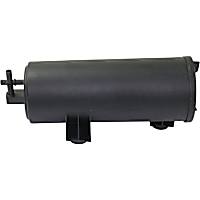Is your vehicle recording a P0496 on your OBD-II scanner? This code, which is one of the many OBD-II codes that can trigger the Check Engine Light, may not present any driving issues and won’t affect the safety of your vehicle, but it can result in engine damage if left unchecked.
What Does the P0496 Code Mean?
OBD-II code P0496 stands for “EVAP Flow During a Non-Purge Condition.” It is a generic powertrain code that affects a variety of vehicles with both an evaporative emission control (EVAP) system and onboard diagnostics. If you see P0496 on your scanner, it simply means that your car’s computer believes the EVAP system is purging out fuel vapor when it shouldn’t be.
Code P0496 indicates there is purge flow or more than 10 inches of water vacuum detected in the EVAP system and fuel tank when purge flow is not being commanded. Water vacuum is very weak compared to inches of mercury (Hg). This can be a problem with the canister purge valve, the canister purge valve circuit, the PCM, etc. Since the fuel tank pressure sensor is the input the PCM uses to detect this vacuum, the FTP sensor may be slightly out of calibration so as to cause this issue.

Early (pre-OBD2) systems only purged the canister when the engine was above idle and warm. OBD2 systems may purge the canister any time the engine is running, even at idle.
But the ECM/PCM knows it should see a slight change in fuel trim when purging is triggered, and it looks for that. Some vehicles use leak detection pumps, which provide additional input. Suffice to say that if the ECM/PCM detects purge flow when it isn’t commanded, it sets this code p0496.
As an aside, the programming engineers use “cells” to describe sets of criteria when certain things are supposed to happen. And there are many “purge free cells,” meaning, the ECM/PCM will not purge during these times. So, if the programming map indicates that the ECM/PCM is in a “purge free cell” but purge flow is detected, code p0496 is set.
To learn more about the EVAP system and purge valve and how they can trigger codes like p0496, read our technical explanation here.
P0496 in Various Makes
Although it can affect any vehicle regardless of make, code P0496 often happens to owners of GM vehicles (Chevrolet, Pontiac, and Dodge, among others).
In Asian car models, such as Honda, Hyundai, or Mazda, this code may stand for “EVAP system high purge flow,” which means the same thing.
Although EVAP systems in general date back to the 1970s, modern enhanced systems appeared in 1994 but became ubiquitous on passenger cars and light trucks by 1997 with OBD2. But even after OBD2, there were enhanced and non-enhanced systems. The non-enhanced EVAP system doesn’t check the EVAP system for leaks, it only checks for EVAP purge flow; this system can mostly be found on late ‘90s Ford Rangers.

What are the Possible Causes of the P0496 Code?
Code P0496 is often set by a failed purge valve/solenoid that’s stuck open. Unfortunately, there are many other reasons the code may set. That’s why it’s a good idea to perform a thorough diagnosis before replacing any parts.
For proper diagnosis, you may consult a certified mechanic. But if you’re confident in your know-how on EVAP systems, here’s a list of all the potential causes of a P0496 code:
- Faulty EVAP or fuel pressure sensor
- EVAP system hose leak (a common problem in Hyundai vehicles)
- Clogged EVAP canister
- Clogged vapor canister
- A damaged canister purge valve
- Failing purge or vent solenoid/valve
- Faulty purge flow sensor (mostly in Kia and Mazda vehicles)
- Weak electrical connection
- Short circuit (common in Isuzu and Hyundai vehicles)
What are the Common Symptoms of the P0496 Code?
In some cases, an illuminated Check Engine Light may be the only symptom that accompanies a code P0496. Though other issues, such as rough running and other engine performance problems, may also result if fuel vapors are purged at the wrong time.
How to Diagnose the P0496 Code
Because there are many potential causes for code P0496, diagnosis can be extremely difficult. Here is a video to give you an idea of the troubleshooting process:
How to Fix the P0496 Code
Disclaimer: Due to the wide variability in vehicle makes and models, as well as other factors, the following information must not be construed as complete or the only definitive way to address a particular issue. Instead, the following content merely attempts to give you a better idea of what a do-it-yourself approach to the issue might involve. You are encouraged to find more technical resources regarding the subject or take your vehicle to a professional technician for the best results.
As with most OBD-II trouble codes, you won’t find a magic bullet fix for a P0496. There are a variety of possible causes, which means there are different avenues of repair depending on what issue is causing the code to be stored.
If you’re concerned that your fuel tank pressure sensor is giving false readings, you can get it replaced.
While some drivers are more than willing to leave such fixes for a professional to handle, there are others who would prefer to repair their vehicles themselves. This comes with a lot of risks, but you could potentially save a lot of money by cutting labor costs.
Bear in mind that all vehicles are different. When troubleshooting and repairing diagnostic trouble codes, make sure to factor in the make and model of your vehicle for a more accurate fix.
How to Replace the Fuel Tank Pressure Sensor
One way to fix a P0496 code is to replace your vehicle’s fuel tank pressure sensor. Replacement sensors may cost you $10 to $605.
- Park your vehicle on a flat and even surface away from other vehicles.
- Relieve all the fuel pressure in your vehicle.
- Leave your vehicle off overnight to make sure the exhaust is completely cold.
- Disconnect the car battery.
- Fold the rear seat of your vehicle and lift the carpet, if applicable.
- Access your vehicle’s fuel pump.
- Disconnect the cable connected to the fuel tank pressure sensor.
- Remove the old fuel tank pressure sensor.
- Replace it with your new fuel tank pressure sensor.
- Reattach the cable by connecting it to the fuel tank pressure sensor.
- Lower the rear seat and the carpet once you’re done.
- Give your vehicle a test drive.
Where to Get Replacement Parts for Your Vehicle
As mentioned there are several reasons why your vehicle could log the P0496 code. Once you’ve pinpointed the cause, be it a faulty fuel pressure sensor or a problem in the system hose, it’s best to address it immediately. If you need part replacements, CarParts.com makes it easy to find what you need.
Here at CarParts.com, it only takes a few clicks to find the right piece. Simply input your vehicle’s information to pull up products that fit your ride. Then, change the filters to find the ones that match your preferred brand, price, and specs.
All our replacement parts come with a low-price guarantee to help you get the best value for your money. On top of that, you can get your order in just a few days, thanks to our fast and reliable shipping. After all, our parts are on hand and ready to ship from strategically located distribution centers across the country.
Check out our catalog today.
Products Mentioned in this Guide
Any information provided on this Website is for informational purposes only and is not intended to replace consultation with a professional mechanic. The accuracy and timeliness of the information may change from the time of publication.



 Vapor Canister
Vapor Canister
 Purge Valve
Purge Valve
 Fuel Pressure Sensor
Fuel Pressure Sensor

















oh my yessss so much help…thanks so much